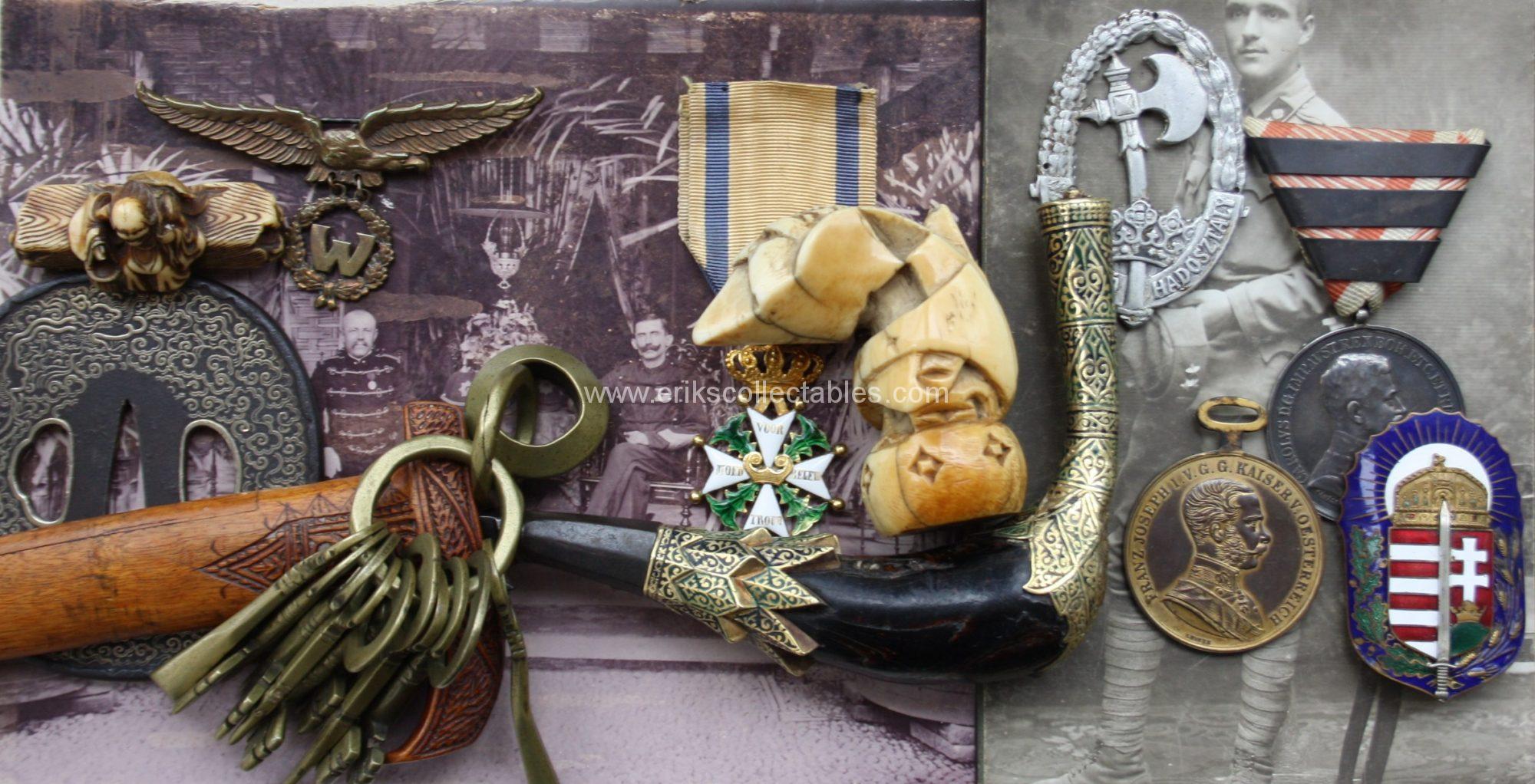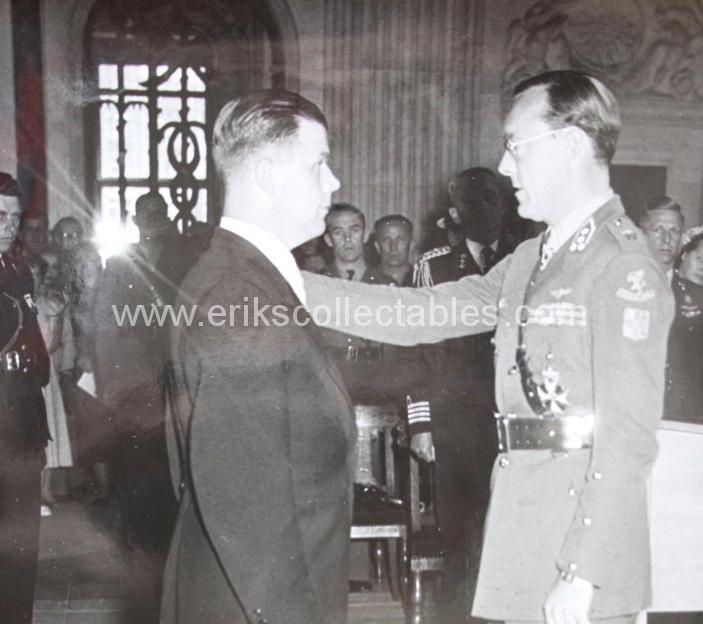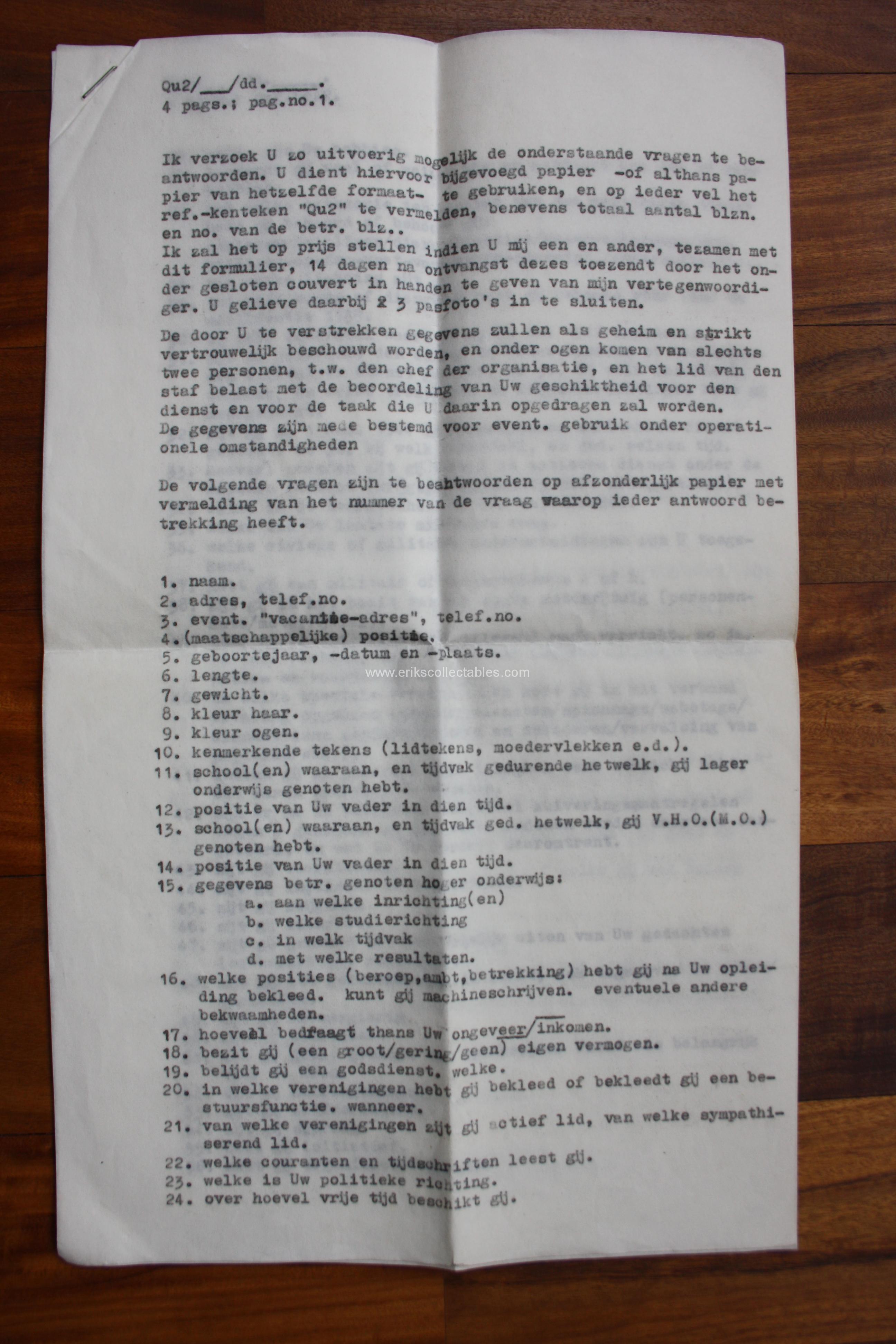OK this is a stretch for me as a researcher. I like to stick to facts only. Not that I cannot enjoy a nice conspiracy theory related movie or book but for historical publications it is not my “thing”. In this case I have a working hypothesis that may raise some eyebrows.
What I will do is state facts that have been published before. The limitation to facts is difficult in this specific case as the most relevant archives have either been destroyed or will not be open to public for a long time to come. So I will add some interpretation of information as well. Anything that is not a fact comes in the last part of the article and is clearly stated as such!.
So please read and judge for yourself and if you have facts to add please feel free to contact me!
This story is about some paper materials from the estate of Chris Navis. Some I bought, others I received as a gift through a collecting friend (thanks again Henk-Willem) in 2010. The materials came on the market when a house was cleared out, probably that of the late Chris Navis. The stack of papers were very diverse. Before the war Navis was an officer. During the war he had an important role in the Dutch resistance against the German occupation. And after the war he was an officer again, now in the Dutch East Indies. The papers cover a period from the late 1930s into the 1950s and relate to different themes. From congratulations upon his receipt of the US Medal of Freedom with Palm but also buying an officers saddle and some strange papers that are the reason for this article.

For his work in the resistance he received the Military Order of William 4th class (MWO4). The highest Dutch decoration for (military) bravery. A true rarity and one of my main research interests. So reason for me to be very happy with this paperwork that I am now the custodian of.
His citation for the MWO4 is an interesting but somewhat difficult text, even in my native Dutch, so I have tried to translate it here to the best of my ability:
“Has distinguished himself during the German occupation by showing excellent deeds of courage, conduct and loyalty by, from August 1941 to September 1944 at first for a paramilitary resistance group and so for the Interior Forces (Binnenlandse Strijdkrachten, the national resistance), fully independently and across the country with great risks as a consequence of frequent enemy infiltration and because he was wanted by the Gestapo, to make and activate the indispensable contacts for the building of the interior military resistance. Due to his uncommonly great experience and critical insight has been able on multiple occasions during his dangerous travels and meetings to barely escape arrest, and on the other hand has been able to warn many for imminent threats and thereby diminishing the vulnerability of the internal connections within the underground resistance.
Thereby and specifically by his outstanding conduct he has highly contributed to the building of a widely extended and safe resistance, that contributed in the fields of espionage and sabotage and other important services to the allied warfare,
Despite his seriously detoriated health as a consequence of his restless activity, tension and starvation, he completed in September 1944 an important mission by moving south and make contact with the Commander of the Interior Forces, the Intelligence Service and the Chief of Staff of the Military Authority.
He was an example of the never selfsparing spirit of resistance.”
Stay Behind network in the Netherlands – not Gladio!
Gladio is a name that rings a bell to many people. Few know exactly what it was but it became a synonym for all Stay Behind networks in Europe. In fact it was the name of the Italian Stay Behind organization that received very negative publicity. Similar Stay Behind networks in other countries also received a negative name due to this and often were wrongfully attached to the same name. I will discuss some basic information regarding the Dutch Stay Behind organization here. My text is based on both the academic and the state publication mentioned in the sources so “facts” not “conspiracy theory” as there seem to be many of these as soon as the Gladio name comes up. These publications only mention names of the leadership of the related organizations who already have passed away and whose names were already known to the public. Names of other members for as far as they have been archived were secret and remain so.
After WW2 the fear for another war was widespread both in Europe and in the US and the risk of a war with Russia was seen as realistic. Experiences in Europe with the resistance, espionage and counter espionage (such as the infamous Englandspiel that caused many casulties) had a strong impact on the steps that would be taken as a precaution for that anticipated war.
As early as 1946 the Dutch Intelligence community started with, what later would be known as, the Stay Behind organization that would be active up to 1992. Most of that period the existence was largely unknown to the general public and kept out of the papers.
In 1946 a main person of the Dutch resistance Dr. Henk Veeneklaas (also knight MWO4!) contacted Prince Bernhard as head of the Interior Forces regarding the forming of a Stay Behind network. The Prince brought him in contact with L. Eindhoven the head of Dutch Intelligence who was soon convinced of the use of such a network. The network would, in case of an occupation by presumably the Russians, be the foundation of the new resistance, espionage and sabotage. No such organization was in place at the start of the German occupation despite plans to do so dating from before the war. The complete resistance, communication etc. had to be organized during the war from scratch by people like Navis. They did so at great personal risk and with many casualties in the process.
Veeneklaas was backed by the Dutch Minister President of that moment and started the training of new agents for this new organization. For the organization he sought mainly agents and instructors that had participated in the resistance in occupied Holland. The organizations official name would, like its Anglo-Saxon counterparts, be an acronym I&O, for Intelligence and Operations (Inlichtingen en Operaties).
Chris Navis – I&O /Stay Behind agent or instructor?
The above mentioned characteristics would have made Navis a very fitting candidate for a role as agent and/or instructor in the new I&O / Stay Behind organization. Reading his MWO4 citation he was an accomplished agent during the war with loads of actual experience that only a few survivors could boast and on top of that a military background and training.
The names of the agents and instructors of this organization are still secret today and unfortunately most documents were destroyed and not archived so the question of who were part of the I&O organization may never be fully answered.
But there are some documents in this group of papers that caught my interest. To be honest I did not know what to think of them at all until I started reading about the Dutch I&O / Stay Behind organization a few years later.
My working hypothesis is that Navis was an agent/instructor in the I&O organization
So from here onward it is speculation, based on a few documents that were part of this larger group of papers. No hard facts but only circumstantial information!
So let’s start with reviewing some of these papers. First two small letters signed by a person named Van Eyk. They indicate some sort of working relationship that existed between March 30th 1951 and February 2nd 1953.


The first is the planning of an appointment. The second letter states that this Van Eyk is sorry for the loss of energy spent by both sides (he indicates the receipt of a letter, probably a resignation) but that the content of the statement made on March 30, 1951 (the date of the meeting in the first letter) will be unabated applicable to him.
Ok any significance? Maybe. Van Eyk was the alias Veeneklaas used during the WW2.. Based on the Pivot report (see sources) he continued to use this name during his role in the post war Stay Behind operation. So is the Van Eyk of these letters Dr. Veeneklaas or is the name just a coincidence? And what is the statement Navis will be held to, one of secrecy?
And than the typewritten text below:
“You will sit on the given date at 20.00 hrs in the 2nd class restaurant of the Central Station in Utrecht. In front of you on the table you will have a copy of ELSEVIER while you are reading a copy of LIFE yourself, of which the cover will be clearly folded outward.
You will be spoken to with the words “Have you been waiting here long?” on which you will reply “four minutes”.
You will use an alias.”

Ok any significance? Maybe. The text is not for a normal meeting I would say. And it is not a wartime text either as LIFE was not available in German occupied Holland. It sounds like a secret agent type of meeting. Maybe training? If I had found this paper outside of this Navis collection I would probably have laughed about it because of this stereotype spy text. Maybe not so stereotype yet in the 1950s?
Next two letter covers. Of what they exactly are I have no clue.
Ok any significance? Maybe. What I found interesting is that both were sent from Utrecht Central Station. The location of the meet up above. And who sends letters from a Railway Station anyway? Not the most regular location. You write a lettercover with a typewriter (at home or in an office) and then you carry it to the railway station to send it away? It is a neutral location in a big city so not traceable, very spylike again?

And what is going on with the material of these envelopes? Made of maps? Wartime surplus stock maps recycled? I honestly do not know. I do know I have not seen such covers before or after and none of the other period covers in the group are like this or have a railway station stamp.

And finally a 4 page questionnaire with the most amazing questions. Way to much to translate but with questions that I cannot place in any regular environment apart from a secret organization. And the heading is clearly very organized too.
A quotes from the starting text:
“The information you will give will be considered secret and be viewed by 2 persons only, namely the boss of the organization and the memeber of the staff that will review if you are qualified for the service and for the task that you will recieve there. This information is also aimed at use in the case of operational circumstances”
The organization – without naming it that is a bit peculiar, right? Secret and only viewed by 2 people, that does not seem to be for a regular job interview? And what are operational circumstances? After that loads of questions regarding military service and resistance work like below:
39. have you in any way done resistance work. if so in which form and when.
40. in which special operations have you, in regard to this, had experience (courier/espionage/sabotage/coding/falsifying papers etc)
Questions about personality, spouse and her personality, family etc etc. totaling to 125 separate questions.
Conclusion?
No conclusion – but my working hypothesis remains that Navis was a member of the I&O / Dutch Stay Behind organization in the 1950s.
His wartime experience would have made him an ideal candidate, the timing fits with the building up phase of the I&O organization and these additional papers seem to hint at such a type of organization. Together they make it a distinct possibility. And so far no facts have come to light to dismiss the hypothesis…..
What do you think? Do let me know!
Sources:
- Herman Schoemaker: Een geheime organisatie in Beeld, De Nederlandse stay-behind-organisatie, geheim, onafhankelijk en zelfstandig? Published in 2013 as a thesis assignment. Can be found on:
- Formal institutional research by the Dutch State archives regarding the Dutch Stay behind organisation by D. Engelen in 2005:





